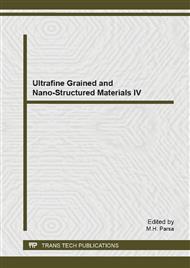[1]
Prepared by the Wisconsin Department of Health Services Division of Public Health with funds from the Agency for Toxic Substances and Disease Registry Public Health Service U.S. Department of Health and Human Services P-00261 (05/2011).
DOI: 10.1037/e369472004-001
Google Scholar
[2]
Driscoll CT and Letterman RD (1988) Chemistry and fate of Al III in treated drinking water. J. Environ. Eng. Div., ACSE 114 (1) 21-37.
DOI: 10.1061/(asce)0733-9372(1988)114:1(21)
Google Scholar
[3]
Schecher WD and Driscoll CT (1988) An evaluation of equilibrium calculations within acidification models: The effect of uncertainty in measured chemical components. Water Resour. Res. 24 533-542.
DOI: 10.1029/wr024i004p00533
Google Scholar
[4]
Rahman A (1992) Residual Aluminum in Treated Water. M. Sc. Thesis, State University of New York at Buffalo, NY.
Google Scholar
[5]
(Schecher and Driscoll, 1988; Crapper and Boni, 1980; Davidson et al., 1982; Martyn et al., 1989; Gardner and Gunn, 1991; Jekel, 1991).
Google Scholar
[6]
^ Banks, W.A.; Kastin, AJ (1989). Aluminum-induced neurotoxicity: alterations in membrane function at the blood–brain barrier,. Neurosci Biobehav Rev 13 (1): 47–53. doi: 10. 1016/S0149-7634(89)80051-X. PMID 2671833.
DOI: 10.1016/s0149-7634(89)80051-x
Google Scholar
[7]
Costello JJ (1984) Post precipitation in distribution systems. J . AWWA76 (11) 46-49.
Google Scholar
[8]
Hudson WD (1966) Studies of distribution system capacity in seven cities. J. AWWA 58 (2) 157-164.
Google Scholar
[9]
Federal Register (1991) Jan 30, 56: 20: 3573.
Google Scholar
[10]
Letterman RD and Driscoll CT (1994) Control of residual aluminum in filtered water. AWWA RF Report, AWWA, Denver, CO 80235. 1-93.
Google Scholar
[11]
Reproduced from Water Quality and Treatment (1990).
Google Scholar
[12]
Reproduced from Water Quality and Treatment (1990) A Handbook of ommunityWater Supplies. Pontius FW (ed. ) AWWA Publication (4th edn. ) 1990, McGraw-Hill Inc., New York. Reproduced with permission of the McGraw-Hill Companies.
Google Scholar
[13]
V. Padmavathy, P. Vasudevan S.C. Dhingra, Biosorption of Ni (II) ions on Baker's yeast, Process Biochem. (Oxford, UK) 38(2003) 1389 - 1395.
DOI: 10.1016/s0032-9592(02)00168-1
Google Scholar
[14]
S. Yee Mak, D. Hwang chen, Binding and sulonation of poly (arylic achd) on Iron oxide nanoparticles: a novel, Magnetic, Strong Acid cationNano- Adsorbent, Macromol. Rapid Commun. 26 (2005) 1567-1571.
DOI: 10.1002/marc.200500397
Google Scholar
[15]
S.Y. Lee, M.T. Harris, Surface modification of magnetic nanoparticles capped by oleic acids: characterization and colloidal stability in polar solvents, J. Colloid Interface Sci. 293(2006) 401-408.
DOI: 10.1016/j.jcis.2005.06.062
Google Scholar
[16]
P.S. Haddad T.M. Martins, L.D. Souza- Li, L.M. Li, K. Metze, R.L. Adam, M. Knobel, D. Zanchet, Structural and morphological investigation of magnetic nanoparticles based on iron oxides for biomedical applications, Mater. Sci. Eng. C 28 (2008).
DOI: 10.1016/j.msec.2007.04.014
Google Scholar
[17]
D. Hritcu, M.I. Popa, N. Popa, V. Badescu, V. Balan, Preparation and characterization of magnetic chitosan Nanospheres, Turk. J. Chem. 33 (2009) 785-796.
DOI: 10.3906/kim-0812-42
Google Scholar
[18]
Z.L. Liu, H.B. Wang, H. Q, Lu, G.H. Du , L. Peng, Y.Q. Du,S.M. Zhang, K.L. Yao, Synthesis and characterization of ultrafine well-dispersed magnetic nanoparticle, J. Magn. Magn. Mater . 283(2004) 258-262.
DOI: 10.1016/j.jmmm.2004.05.031
Google Scholar
[19]
J. Hu, G. Chen, M.C. Lo, Selective removal of heavy metals from industerial wastewater using Maghemite nanoparticle : performance and mechanism, J. Environ. Eng. 132 (2006) 702. 715.
DOI: 10.1061/(asce)0733-9372(2006)132:7(709)
Google Scholar
[20]
Y.C. Sharma, V. Srivastava , Separation of Ni(II) ions from aqueous solution by magnetic nanoparticles, J. Chem . Eng . Data 55(2010) 1441-1442.
DOI: 10.1021/je900619d
Google Scholar
[21]
Y.C. Sharma, V. Srivastava, C.H. Weng, S.N. Upadhyay, Removal of Cr (VI) from wastewater by adsorption on Iron Nanoparticles, Can.J. Chem. Eng. 87(2009) 921-929.
DOI: 10.1002/cjce.20230
Google Scholar
[22]
Y.C. Chang .D.H. Chen, Adsorption kinetics and thermodynamics of acid dyes on a carboxy methylated chitosan – conjugated magnetic nano-adsorbent, Macro Mol, Biosci, 5(2005) 254-261.
DOI: 10.1002/mabi.200400153
Google Scholar
[23]
A.S. Teja, P.Y. Koh, Synthesis, properties, and application of magnetic iron oxide nanoparticles, Proger Crystal Growth character Mater. 55(2005) 22-45.
Google Scholar
[24]
J. Zhou,W. Wu,D. Caruntu, M.H. Yu, A. Martin, J.F. Chen C.J.O. Connor, W.L. Zh ou, Synthesis of porous magnetic hollow silica nanospheres for nanomedicine application , J. Phys. Chem. C 111(2007) 17473-17477.
DOI: 10.1021/jp074123i
Google Scholar
[25]
K. Mahalingam, S. Onclin, M. Pe'ter,B.J. Ravoo, J. Huskens, D.N. Reinhoudt, Directed self assembly of functionalized silica nanoparticles on molecular printboards through multivalent supramolecular interactions, Langmuir 20(2004) 11756-11762.
DOI: 10.1021/la047982w
Google Scholar
[26]
L.M. Rossi, A.D. Quach, Z. Rosenzweig, Glucose oxidase – magnetic nanoparticle bioconjugate for glucose sensing, Anal. Bioanal. Chem. 380 (2004) 606-613.
DOI: 10.1007/s00216-004-2770-3
Google Scholar
[27]
L. Wang, J. Bao, L. Wang, F. Zhang, Y. Li, One-pot synthesis and bioapplication of amine- functionalized magnetic nanoparticles and hollow nanospheres, Chem. Eur.J. 12 (2006) 6341-6347.
DOI: 10.1002/chem.200501334
Google Scholar
[28]
A. -H. Lu, E.L. Salabas, F. Schuth, Magnetite nanoparticles: synthesis, protection, functionalization and application, Angew. Chem. Int . Ed. 46 (2007) 1222-1244.
DOI: 10.1002/anie.200602866
Google Scholar
[29]
J. Park, K. An, Y. Hwang, J.G. Park, H.J. Noh, J.Y. Kim, J.H. Park, N.M. Hwang, T. Hyeon, Ultra large-scale synthesis of monodisperse nanocrystals, Nat. Mater. 3 (2004) 891-895.
DOI: 10.1038/nmat1251
Google Scholar
[30]
J.H. Jang, H.B. Lim, J. Microchem. 94 (2010) 148–158.
Google Scholar
[31]
Standard methods for the examination of water and wastewater 20th edition-3500 Al B-Eriocorom cyanine R method.
Google Scholar


